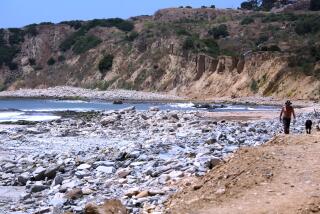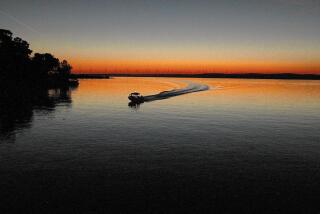Heavy Rains Killing Off Mugu Lagoon : Environment: Runoff carries sediment and pollutants into water, turning it into a salt marsh and endangering plant and animal life, activists and federal report say.
POINT MUGU — While the season’s downpours have been a joy to drought-weary water users, they have been quietly killing Mugu Lagoon and endangering its plants and animals, environmentalists say.
Ron Dow, head of Point Mugu Naval Air Station’s environmental division, said heavy rains during the last two years have accelerated runoff into the streams and creeks that flow into the lagoon.
In addition to carrying pesticides and herbicides from farms upstream, the fresh water upsets the saltwater lagoon’s delicate balance.
The most significant threat, according to a federal report, is the sediment that is picked up along the 325-square-mile watershed and dumped into the lagoon.
“Significant sediment loads carried by flood flows are resulting in rapid filling of Mugu Lagoon, thereby endangering the longevity of this vital fish and wildlife habitat,” the report by U.S. Department of Agriculture officials said. “At the present rate . . . Mugu Lagoon would have little open water in 50 years and would be upland in 100 years.”
Dow can do little but watch as the lagoon he is paid to protect turns into what he calls “a high meadow.”
“The flow is putting as much as four feet of mud and sediment into the lagoon during a single large storm, where it should be filling about half an inch a century,” Dow said. “Some areas already take an extreme high tide to be under water.”
The lagoon, Ventura County’s largest wetlands and wildlife sanctuary, was once 3,000 acres of open water. It is now a 1,100-acre salt marsh.
Among the more than 250 species of birds observed in the area are five that are endangered: the peregrine falcon, the brown pelican, the least tern, Belding’s savannah sparrow and the light-footed clapper rail.
Another endangered species is the salt marsh bird’s beak, a flowering bright purple plant that thrives near saltwater bodies.
The area is also treasured as one of the few breeding grounds for harbor seals and as a major stopping-off point for migratory birds.
The lagoon’s troubles are part of a larger phenomenon: the disappearance of wetlands across the country, said Bill Supri, president of the Conejo Valley Audubon Society.
“We’ve only got about 5% of the original wetlands left in the state,” said Supri, who visits the lagoon twice a week. “They are under siege virtually all the time.”
Environmentalists place much of the blame for the demise of the lagoon’s ecosystem on agriculture and the rash of development--from shopping centers and condominium complexes to golf courses and sewage treatment plants--that have been built during the past decade.
“There’s a lot of blame to go around,” said Tim Kuhn, a team leader with the Soil Conservation Service, a Davis-based state agency that is studying the area’s watershed. “It’s agriculture, it’s urban development, it’s streets, it’s everything that ends up in streams and storm drains that finds its way into the system and ends up at the lagoon.”
Greg Smith, a senior planner for the city of Thousand Oaks, which sits in the middle of the watershed and in the path of much of the water that comes coursing to the lagoon, said the city has taken steps to reduce runoff.
“As part of our environmental reporting process, all projects are looked at and all developments are required to have no more runoff than would occur naturally,” Smith said.
Al Echarren, the county’s manager of development and inspection services, said the county forces new developments to retain most rainwater until a storm’s hardest rains have passed.
But Supri said such policies overlook pollutants that get into the watershed system.
Meanwhile, the California Coastal Commission is working on a legislative proposal, due in 1995, that would seek to safeguard coastal watersheds from pollution, including sedimentation, said Bill Allayaud, the project’s coordinator.
And at Point Mugu, the Mugu Lagoon Task Force is developing a plan that will integrate conservation efforts among 12 agencies in the watershed, said Sheri Klittich, a researcher with the Soil Conservation Service.
While such news encourages Dow, he said he is amazed at the speed at which parts of the once-swampy lagoon have turned into solid ground.
“As late as the 1970s, this was all under 30 feet of water,” he said, sweeping his hand from atop a hill overlooking the lagoon. “It’s natural for lagoons to fill, but this is really accelerated. It’s still a little hard to believe.”
More to Read
Sign up for Essential California
The most important California stories and recommendations in your inbox every morning.
You may occasionally receive promotional content from the Los Angeles Times.










